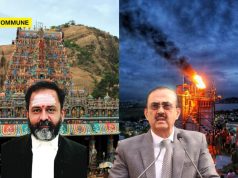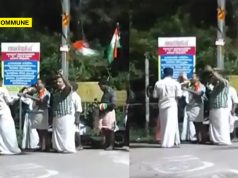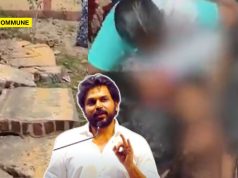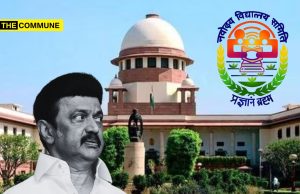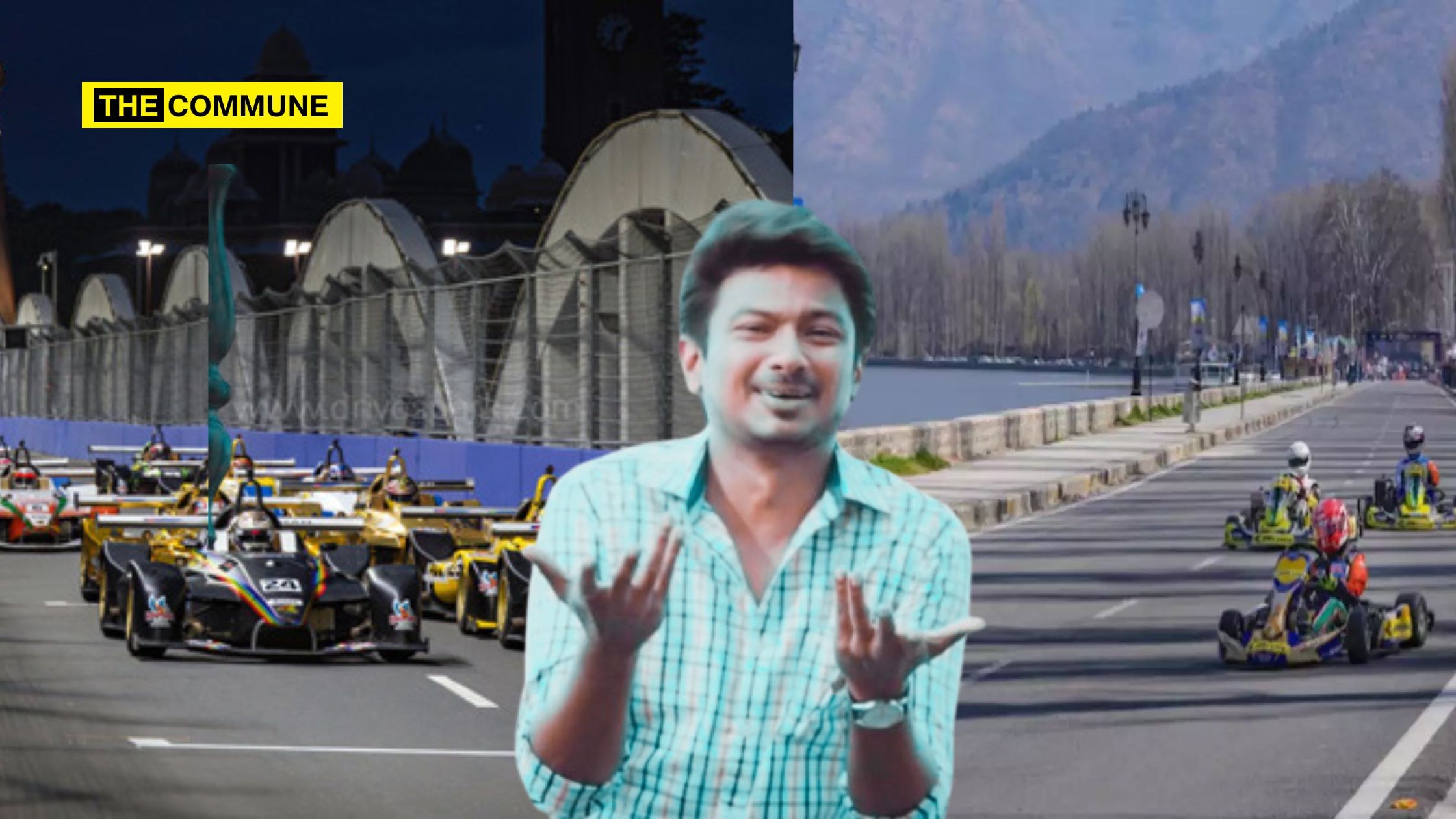
While the roar of engines filled the air in Srinagar and Chennai this year, the stories behind the Formula 4 races couldn’t be more different. Srinagar’s race event, held on the banks of Dal Lake, showcased a transformed region, highlighting normalcy after the abrogation of Article 370. In contrast, Chennai’s night race was marred by delays, safety concerns, and frustration, raising questions about the DMK government’s execution and priorities.
So far, the DMK has been criticized for claiming central government schemes as their own. Recently, it has come to light that their latest claims are also questionable. For example, the recently concluded “Formula 4” night street race, a pet project of DMK scion Udhayanidhi Stalin, was touted by the Dravidian faction as ‘Asia’s first.’ However, this claim is false, as the Formula 4 format had already been held on 17 March 2024, on the banks of Dal Lake in Srinagar, located along Boulevard Road in the Zabarwan Mountain Range by the BJP.
#Srinagar hosts its first-ever #Formula4 car race from on the banks of #DalLake pic.twitter.com/fkAhV9gI8J
— DD News (@DDNewslive) March 18, 2024
If you take a little background check, the F4 Indian Championship is a single-seater motorsport series adhering to the FIA’s Formula 4 regulations and organized by Racing Promotions Pvt Ltd. The series began its inaugural season in 2023, making the Dravidian faction’s claim about it being a unique event incorrect.
Real Difference Between The 2 Events – A Closer Look
Srinagar’s Formula 4 race was a significant achievement, showcasing the restored normalcy in Kashmir after Article 370 was abrogated. In the very streets where stone pelting used to be common, officials hosted such a prestigious event highlighting the region’s progress.
Unlike Udhayanidhi Stalin’s approach, the BJP didn’t spend ₹42 crores on extravagant road improvements or an additional ₹40 crores to host the Formula 4 race. This begs the question – if the BJP managed to execute the Srinagar’s race event efficiently without excess spending, why did the Chennai event cost over ₹80 crores? If Chennai still has to resort to elaborate events to attract investors, it indicates a failure in addressing broader issues by the current DMK regime. In contrast, Kashmir needs to display its newfound stability following the abrogation of Article 370, a change primarily credited to Home Minister Amit Shah.
In Srinagar, the race was open to the public from the banks of Dal Lake at no cost, whereas the Chennai event charged ₹1000 to ₹20,000 for tickets. It’s puzzling that some people equate such costly events with social justice. Unlike in Chennai, the UT Administration in J&K didn’t need to plead in court for FIA certification; their primary goal was to demonstrate Kashmir’s return to normalcy. Additionally, the Srinagar’s race event was not a public nuisance there were no road closures or traffic diversions, and public funds were not wasted.
Formula 4 in India. The TRUTH!
DMK is boasting of conducting Formula 4 in Chennai. But, THIS is NOT THE FIRST TIME, a formula 4 has held in India. In March 2024, the @narendramodi Government has conducted a Formula 4 Racing event in SRINAGAR!
What's the difference ??
– To… pic.twitter.com/TUqFmAqVLc
— The Indian Professor (@Prof_Indian) September 3, 2024
Let’s examine the chaos they created both during and in the lead-up to the event.
Failed To Get Clearance On Time
Racing Promotion Private Limited (RPPL) organized the event, which hit a snag when it failed to secure the necessary clearance from the Federation Internationale de l’Automobile (FIA) by the noon deadline set by the Madras High Court. As a result, RPPL petitioned the court for a six-hour extension.
RPPL explained to the special bench that unexpected rain on the evening of 30 August had delayed some critical work. They had invested over ₹200 crore into the event, with more than 5,000 tickets sold. They argued that not granting the extension would cause significant prejudice and hardship. A special bench of Justices R. Suresh Kumar and P.B. Balaji granted an extension until 8 p.m. when the FIA clearance was finally received.
Spectators Left High & Dry
The delay was particularly exasperating for fans who had braved the sweltering heat only to be met with uncertainty. Information about the delay was scarce, leaving many spectators wondering when the event would commence.
One attendee, who had paid around ₹20,000 for tickets for himself and his two children, expressed frustration. “We were excited about the night race coming to Chennai, but the organization has been a letdown. My kids followed car racing closely and were looking forward to this,” he said.
#Chennai Formula 4 racing is a supreme mess up by the #TNGovt
Outside Kalaignar memorial, a dad with 2 kids (aged 5,11), are not permitted to enter venue, don't have any clear instructions from @Paytm. They paid ₹20K+ for 3 tickets
This seems like a massive scam #TamilNadu pic.twitter.com/G1kgtYN37D— Sidharth.M.P (@sdhrthmp) August 31, 2024
This year’s Formula 4 championship in India has been held over five rounds, with the second round ending in Chennai. On 1 September, the turnout was notably lower compared to 31 August, as only those with tickets attended. The previous day had seen a large crowd, many of whom thought entry was free.
K Shiva, who travelled from Kumbakonam to watch the Formula 4 event, expressed frustration, “We were told either entry would be free, or ticket prices would be low. However, there was a lack of clear guidance from the authorities, and we ran from gate to gate without proper information.” As a result, nearly half of the attendees from Saturday left after discovering that admission was not free.
Information for ticket holders was scarce, leaving many spectators confused and frustrated.
Circuit Not Well Done – Safety Issues
The day’s schedule included free practice and qualifying sessions for the Indian Racing League (IRL), Formula 4 Indian Championship (F4IC), and the JK Formula LGB 4 categories. The F4 free practice session, initially set for 1:45 p.m., was delayed after an FIA inspection at 11 a.m. revealed that two corners of the circuit were not up to standard and needed modifications for approval. RPPL then rushed back to court for an extension, granted at 5 p.m. when the FIA approved the circuit for a G3 licence.
The FIA’s statement clarified that while the circuit licence ensured a minimum level of safety, it did not guarantee absolute safety for the event, which remained the responsibility of the circuit owners and event organizers. As a result, the entire tournament schedule was shifted, with 31 August 2024 night’s qualifying sessions moved to 1 September 2024.
The chaos finally subsided around 9 p.m., and spectators could finally at least enjoy the practice sessions. The roar of engines and the sight of cars racing through the illuminated streets restored excitement for the event.
Car Collision
In the main race on 1 September 2024, a collision between two cars during the final lap caused the race to be temporarily halted. Dark Don Racing’s T.S. Diljith, who had maintained the lead throughout the race, was declared the winner after the interruption.
Overall, the DMK’s Formula 4 event was marred by hype and haste, resulting in considerable frustration among fans and enthusiasts. The execution fell short of expectations, revealing the DMK’s inability to manage a sporting event effectively. It appeared that the event was treated more like a DMK affair than a professional racing competition, with the FIA’s approval coming only at the last minute, placing the burden of responsibility on the organizers. The collision between cars during the race was not fully explained or investigated, leading political commentators to criticize the DMK for allegedly downplaying the issue.
ஃபார்முலா 4 கார் பந்தயம் – விபத்து காரணமாக போட்டி பாதியிலேயே நிறுத்தம்! போட்டியை இத்தோடு முடித்து கொண்டு விபத்தை மூடி மறைக்க முயற்சி?
விபத்து நடந்த போட்டோ கூட வெளியே வரக்கூடாது என மீடியாக்களுக்கு வாய் மொழி உத்தரவு?
இதன் மீது முழு ஆய்வு அறிக்கையை தமிழக போக்குவரத்து காவல் துறை…
— Maridhas (@MaridhasAnswers) September 1, 2024
Stray Dogs Loitering On Circuit, Bikers Performing Stunts
Organizers seemed unprepared for behaviours, such as stray dogs running on the track and bikers using it for stunts. Such activities further compounded the chaos before the Formula 4 event finally began.
Mr. @RSBharathiDMK…. what B.A graduate doing there??? #F4Chennai pic.twitter.com/fX8cK9gipC
— Ponlokesh (@ponlokesh) August 31, 2024
FORMULA 4 TRACK-ல் RACE ஓடிய நாய்..!#Chennai #Formula4 #Formula4Chennai #Formula4CarRace #Formula4Racing #Dog #NewsTamil #Newstamil24x7 pic.twitter.com/2iwZz49Gs9
— News Tamil 24×7 (@NewsTamilTV24x7) September 1, 2024
Overall, the DMK’s racing event in Chennai appears more as an attempt to mask the failures of the Dravidian Model in Tamil Nadu rather than to foster enthusiasm and inspiration for racing genuinely. If their intention had been sincere, they would have chosen race tracks on the outskirts rather than the city center.
The Formula 4 race events in Srinagar and Chennai offered a stark contrast in execution and outcomes. The Srinagar’s race was a testament to the region’s progress and the government’s ability to successfully host a major sporting event. In contrast, Chennai’s race was a chaotic affair that exposed the DMK government’s shortcomings in organization and planning. While the race event may have been a temporary distraction from the state’s pressing issues, it ultimately revealed more about the government’s priorities and capabilities than it did about the sport of racing.
Subscribe to our Telegram, WhatsApp, and Instagram channels and instantly get the day’s best stories.

